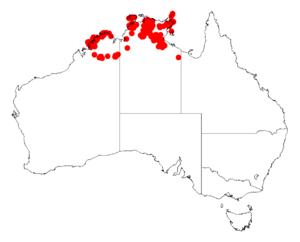Wuluru facts for kids
Quick facts for kids Wuluru |
|
|---|---|
| Scientific classification | |
| Genus: |
Acacia
|
| Species: |
gonocarpa
|
 |
|
| Occurrence data from AVH | |
The wuluru (scientific name: Acacia gonocarpa) is a type of tree or shrub. It belongs to the large Acacia family, which is also known as wattles. You can find wuluru growing naturally in the northern parts of Australia.
Contents
What Wuluru Looks Like
This plant can be a tall shrub or a small tree. It usually grows between 1 to 7 metres (3 to 23 ft) high. The wuluru often has many stems and branches that spread out or droop down. Its top part, called the canopy, is not very dense.
The bark on the trunk is smooth when the plant is young. As it gets older, the bark near the bottom of the trunk develops small cracks. The younger branches have angles, but they become rounder with tiny ridges later on.
Leaves and Flowers
The wuluru has special leaf-like parts called phyllodes. These are not true leaves but flattened stems that act like leaves. They usually grow one by one, but sometimes in groups of two or three. The phyllodes are long and narrow, like a line or a thin oval. They can be straight or slightly curved upwards. They measure from 1.5 to 14 centimetres (0.6 to 5.5 in) long and 0.7 to 1.8 millimetres (0.028 to 0.071 in) wide. Each phyllode has a clear line down the middle.
Wuluru plants bloom, or flower, from December to June. They produce pretty yellow flowers. These flowers grow in spikes, either one or two at a time, where the phyllodes join the stem. The flower spikes can be up to 3 cm (1.2 in) long. The flowers themselves are pale yellow or cream colored.
Seeds and Pods
After flowering, the wuluru produces woody, dark brown seed pods. These pods have small wings on them. They can be straight or curved and are about 2 to 8.5 cm (0.79 to 3.35 in) long and 3 to 6 mm (0.118 to 0.236 in) wide. Inside these pods, you will find brown seeds.
How Wuluru Got Its Name
Scientists give every plant and animal a special scientific name. This helps everyone around the world know exactly which plant they are talking about.
The wuluru was first officially described in 1859. A botanist named Ferdinand von Mueller gave it the name Acacia gonocarpa. He wrote about it in a science journal. For a short time in 2003, another scientist, Leslie Pedley, changed its name to Racosperma gonocarpum. But in 2006, it was changed back to Acacia gonocarpa. This shows how scientists sometimes update names as they learn more!
Where Wuluru Grows
The wuluru plant is found in northern Australia. You can see it in the Kimberley area of Western Australia. It also grows in the Northern Territory, from Melville Island in the north down to Kakadu National Park.
This plant usually grows among sandstone rocks and hills. It also likes to grow along rocky creeks and rivers, especially in sandy soil. You might find it in open forests where Eucalypt trees grow, or in mixed woodlands. Sometimes, it grows near another plant called Melaleuca nervosa.

